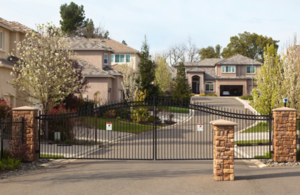Crime Prevention Through Environmental Design (CPTED) Gated Communities
Today many homeowners are separating themselves from criminals by residing in gated communities. By definition, gated communities use access control points in order to privatize what would otherwise be public spaces. This segregation from the general population tends to reduce crime, stabilize property values, and increases a sense of community. However, some argue that gated communities have a negative effect on society because the affluent are insulating themselves from interacting with individuals belonging to a different socio-economic class resulting in a more closed, segregated society.
Would-be criminals prefer to attack a “soft target” with easy access and easy egress. Because of access control, gated communities tend to be unfamiliar to criminals and escape after the crime presents a greater risk. For instance, a home with no natural or man-made barrier, a lack of lighting, and no access control is much more vulnerable and presents a more attractive target to a criminal than a security-minded gated community with access control, surveillance cameras, and quality lighting.

In order to increase the effectiveness of Crime Prevention Through Environmental Design, a gated community should have a clearly defined perimeter such has a fence or high hedge row so that anyone who wishes to enter the community must do so through the access control point. The perimeter is the first line of defense for the community regarding trespassers. The perimeter should be well maintained, free of debris, and disrepair. The perimeter should also be lit, under observation, and patrolled.
Within the perimeter of the community, common areas can be created within a cluster of homes. This further builds a sense of pride within the community and creates a “see something, say something” environment. The common areas should also be well lit and maintained, broken lights, litter, and decay often tend to encourage criminal behavior. However, when common areas are respected and cared for, criminal behavior. However, when common areas are respected and cared for, criminal behavior will tend to dwindle. Community dog parks, playgrounds, and picnic areas can all be constructed in this manner.
Semi-public areas such as streets can be casually monitored and controlled by the community with speed bumps, park benches, and good lighting. Gated communities are home to many small children, speed bumps will especially control speeders keeping kids safer. While well-lit, clean, observable streets within a tight-knit community make it easier to deter and detect potential predators.
CPTED Article PDF
Physical Security Survey





